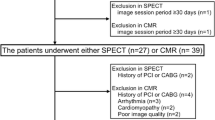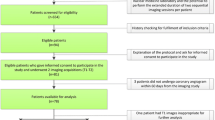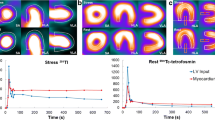Abstract
Background
Information on the accuracy of both magnetic resonance imaging (MRI) and myocardial contrast echocardiography (MCE) for the identification of perfusion defects in patients with acute myocardial infarction is limited. We evaluated the accuracy of MRI and MCE, using Single Photon Emission Computed Tomography (SPECT) imaging as reference technique.
Methods
Fourteen consecutive patients underwent MCE, MRI and 99mTc-MIBI SPECT after acute myocardial infarction to assess myocardial perfusion. MCE was performed by Harmonic Power Angio Mode, with end-systolic triggering 1:4, using i.v. injection of Levovist®. First-pass and delayed enhancement MRI was obtained after i.v administration of Gadolinium-DTPA. At MCE, homogeneous perfusion was considered as normal and absent or “patchy” perfusion as abnormal. At MRI, homogenous contrast enhancement was defined as normal whereas hypoenhancement at first-pass followed by hyperenhancement or persisting hypoenhancement in delayed images was defined as abnormal.
Results
At MCE 153 (68%) of segments were suitable for analysis compared to 220 (98%) segments at MRI (p<0.001). Sensitivity, specificity and accuracy of MCE for segmental perfusion defects in these 153 segments were 83, 73 and 77%, respectively. Sensitivity, specificity and accuracy of MRI were 63, 82, and 77%, respectively. MCE and MRI showed a moderate agreement with SPECT (k: 0.52 and 0.46, respectively). The agreement between MCE and MRI was better (k: 0.67) that the one of each technique with SPECT.
Conclusion
MCE and MRI may be clinically useful in the assessment of perfusion defects in patients with acute myocardial infarction, even thought MCE imaging may be difficult to obtain in a considerable proportion of segments when the Intermittent Harmonic Angio Mode is used.
Similar content being viewed by others
References
Bolognese L, Carrabba N, Parodi G, Santoro GM, Buonamici P, Cerisano G. et al. (2004). Impact of microvascular dysfunction on left ventricular remodeling and long-term clinical outcome after primary coronary angioplasty for acute myocardial infarction. Circulation 109:1121–6
Ragosta M, Camarano G, Kaul S, Powers ER, Sarembock IJ, Gimple LW. (1994). Microvascular integrity indicates myocellular viability in patients with recent myocardial infarction. New insights using myocardial contrast echocardiography. Circulation 89:2562–9
Abe Y, Muro T, Sakanoue Y, et al. Intravenous myocardial contrast echocardiography predicts regional and global left ventricular remodelling after acute myocardial infarction: comparison with low-dose dobutamine stress echocardiography. Heart 2005; 91: 1578–1583
Galiuto L, Lombardo A, Maseri A, Santoro L, Porto I, Cianflone D. et al. (2003). Temporal evolution and functional outcome of no reflow: sustained and spontaneously reversible patterns following successful coronary recanalisation. Heart 89:731–7
Underwood SR, Anagnostopoulos C, Cerqueira M, Ell PJ, Flint EJ, Harbinson M, Kelion AD. et al. (2004). Myocardial perfusion scintigraphy: the evidence. Eur J Nucl Med Mol Imaging 31:261–91
Gibbons RJ, Miller TD, Christian TF. (2000). Infarct size measured by single photon emission computed tomographic imaging with 99mTC-sestamibi: a measure of the efficacy of therapy in acute myocardial infarction. Circulation 101:101–8
Miller TD, Christian TF, Hopfenspirger MR, Hodge DO, Gersh BJ, Gibbons RJ. (1995). Infarct size after acute myocardial infarction measured by quantitative tomographic 99mTc sestamibi imaging predicts subsequent mortality. Circulation 92:334–41
Sinusas AJ, Trautman KA, Bergin JD, Watson DD, Ruiz M, Smith WH. et al. (1990). Quantification of area at risk during coronary occlusion and degree of myocardial salvage after reperfusion with technetium-99 m methoxyisobutyl isonitrile. Circulation 82:1424–37
Maes AF, Borgers M, Flameng W, Nuyts JL, van de Werf F, Ausma JJ, Sergeant P, Mortelmans LA. (1997). Assessment of myocardial viability in chronic coronary artery disease using technetium-99 m sestamibi SPECT. Correlation with histologic and positron emission tomographic studies and functional follow-up. J Am Coll Cardiol. 29:62–8
Schomig A, Kastrati A, Dirschinger J, Mehilli J, Schricke U, Pache J. et al. (2000). Coronary stenting plus platelet glycoprotein IIb/IIIa blockade compared with tissue plasminogen activator in acute myocardial infarction. Stent versus Thrombolysis for Occluded Coronary Arteries in Patients with Acute Myocardial Infarction Study Investigators. N Engl J Med. 343:385–91
Marwick TH, Brunken R, Meland N, Brochet E, Baer FM, Binder T. et al. (1998). Accuracy and feasibility of contrast echocardiography for detection of perfusion defects in routine practice: comparison with wall motion and Technetium-99 m sestamibi single-photon emission computed tomography. J Am Coll Cardiol 32:1260–9
12. Senior R, Kaul S, Soman P, Lahiri A. (2000). Power Doppler Harmonic Imaging: a feasibility study of a new technique for the assessment of myocardial perfusion. Am Heart J 139:245–51
Greaves K, Dixon SR, Fejka M, O’Neill WW, Redwood SR, Marber MS. et al. (2003). Myocardial contrast echocardiography is superior to other known modalities for assessing myocardial reperfusion after acute myocardial infarction. Heart 89:139–44
Heinle SK, Noblin J, Goree-Best P, Mello A, Ravad G, Mull S. et al. (2000). Assessment of myocardial perfusion by Harmonic Power Doppler Imaging at rest and during adenosine stress. Comparison with 99mTc-Sestamibi SPECT Imaging. Circulation 102:55–60
Kim RJ, Chen EL, Lima JAC, Judd RM. (1996). Myocardial Gd-DTPA kinetics determine MRI contrast enhancement and reflect the extent and severity of myocardial injury after acute reperfused infarction. Circulation 94:3318–26
Ibrahim T, Nekolla SG, Hornke M, Bulow HP, Dirschinger J, Schomig A, Schwaiger M. (2005). Quantitative measurement of infarct size by contrast-enhanced magnetic resonance imaging early after acute myocardial infarction: comparison with single-photon emission tomography using Tc99m-sestamibi. J Am Coll Cardiol. 45:544–52
Kim RJ, Wu E, Rafael A, Chen EL, Parker MA, Simonetti O. et al. (2000). The use of contrast-enhanced magnetic resonance imaging to identify reversible myocardial dysfunction. N Engl J Med 343:1445–53
Beek AM, Kuhl HP, Bondarenko O, Twisk JW, Hofman MB, van Dockum WG. et al. (2003). Delayed contrast-enhanced magnetic resonance imaging for the prediction of regional functional improvement after acute myocardial infarction. J Am Coll Cardiol 42:895–901
Rogers WJ Jr, Kramer CM, Geskin G, Hu YL, Theobald TM, Vido DA. et al. (1999). Early contrast-enhanced MRI predicts late functional recovery after reperfused myocardial infarction. Circulation 99:744–50
Gerber BL, Garot J, Bluemke DA, Wu KC, Lima JA. (2002). Accuracy of contrast-enhanced magnetic resonance imaging in predicting improvement of regional myocardial function in patients after acute myocardial infarction. Circulation 106:1083–9
Taylor AJ, Al-Saadi N, Abdel-Aty H, Schultz-Menger J, Messroghli DR, Friedrich MG. (2004). Detection of acutely impaired microvascular reperfusion after infarct angioplasty with magnetic resonance imaging. Circulation 109:2080–85
Tweedle MF. Physicochemical properties of gadoteridol and other magnetic resonance contrast agents. Invest Radiol 1992; 27 (Suppl 1): S2–S6.
Schiller NB, et al. for the American Society of Echocardiography Committee on Standards, Subcommittee on Quantitation of Two-Dimensional Echocardiograms. Recommendations for quantitation of the left ventricle by two-dimensional echocardiography. J Am Soc Echocardiogr 1989; 2: 358–367
Abdel-Aty H, Zagrosek A, Schulz-Menger J, Taylor AJ, Messroghli D, Kumar A, Gross M, Dietz R, Friedrich MG. (2004). Delayed enhancement and T2-weighted cardiovascular magnetic resonance imaging differentiate acute from chronic myocardial infarction. Circulation 109:2411–6
Schulz-Menger J, Gross M, Messroghli D, Uhlich F, Dietz R, Friedrich MG. (2003). Cardiovascular magnetic resonance of acute myocardial infarction at a very early stage. J Am Coll Cardiol. 42:513–8
Foo TK, Bernstein MA, Aisen AM, Hernandez RJ, Collick BD, Bernstein T. (1995). Improved ejection fraction and flow velocity estimates with use of view sharing and uniform repetition time excitation with fast cardiac techniques. Radiology 195:471–8
Kramer MS, Feinstein AR. (1981). Clinical biostatistics: the biostatistics of concordance. Clin Pharmacol Ther 29:111–23
Ito H, Maruyama A, Iwakura K, Takiuchi S, Masuyama T, Hori M. et al. (1996). Clinical implications of the no reflow phenomenon A predictor of complications and left ventricular remodeling in reperfused anterior wall myocardial infarction. Circulation 93:223–8
Zoghbi WA. (2002). Evaluation of myocardial viability with contrast echocardiography. Am J Cardiol 90:65J–71J
Biagini E, Galema TW, Schinkel AF, Vletter WB, Roelandt JR, Ten Cate FJ. (2004). Myocardial wall thickness predicts recovery of contractile function after primary coronary intervention for acute myocardial infarction. J Am Coll Cardiol 43:1489–93
Tousek P, Orban M, Martinoff S, Firschke C. Assessment of infarcted myocardium with real-time myocardial contrast echocardiography: comparison with 99mTc sestamibi single photon emission computed tomography. Heart 2005; 91: 1568–1572
Wu KC, Kim RJ, Bluemke DA, Rochitte CE, Zerhouni EA, Becker LC. et al. (1998). Quantification and time-course of microvascular obstruction by contrast-enhanced echocardiography and magnetic resonance imaging following acute myocardial infarction and reperfusion. J Am Coll Cardiol 32:1756–64
Wagner A, Mahrholdt H, Holly TA, Elliott MD, Regenfus M, Parker M. et al. (2003). Contrast-enhanced MRI and routine single photon emission computed tomography (SPECT) perfusion imaging for detection of subendocardial myocardial infarcts: an imaging study. Lancet 361:374–9
34. Schuijf JD, Kaandorp TA, Lamb HJ, van der Geest RJ, Viergever EP, van der Wall EE. et al. (2004). Quantification of myocardial infarct size and transmurality by contrast-enhanced magnetic resonance imaging in men. Am J Cardiol. 94:284–8
Author information
Authors and Affiliations
Corresponding author
Rights and permissions
About this article
Cite this article
Lombardo, A., Rizzello, V., Galiuto, L. et al. Assessment of resting perfusion defects in patients with acute myocardial infarction: comparison of myocardial contrast echocardiography, combined first-pass/delayed contrast-enhanced magnetic resonance imaging and 99mTC-sestamibi SPECT. Int J Cardiovasc Imaging 22, 417–428 (2006). https://doi.org/10.1007/s10554-005-9045-8
Received:
Accepted:
Published:
Issue Date:
DOI: https://doi.org/10.1007/s10554-005-9045-8




